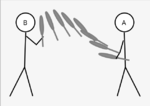User:Karsten/Redesign: Difference between revisions
(Created page with " The goal of this wiki is to offer "learning paths", in which you can begin with simple juggling patterns and then get a suggestion for a few patterns with increasing difficul...") |
No edit summary |
||
| Line 1: | Line 1: | ||
The goal of this wiki is to offer "learning paths", |
The goal of this wiki is to offer "learning paths", starting with simple juggling patterns and then offering a suggestion for a few patterns with increasing difficulty. |
||
BUT: There is more than one type of difficulty and so there is more than one starting point. (For example being able to pass 7 clubs in a 2-count will not help you much in doing a 3 ball Mill's Mess) |
|||
| ⚫ | |||
| ⚫ | |||
| ⚫ | |||
| ⚫ | |||
<!-- == Theory == |
<!-- == Theory == |
||
Revision as of 15:07, 14 March 2022
The goal of this wiki is to offer "learning paths", starting with simple juggling patterns and then offering a suggestion for a few patterns with increasing difficulty.
BUT: There is more than one type of difficulty and so there is more than one starting point. (For example being able to pass 7 clubs in a 2-count will not help you much in doing a 3 ball Mill's Mess)
Each throw type has its own type of difficulty, as has combining different throw types, as has remembering and executing longer pattern sequences of different throws.
The exercises below try to start with different patterns that use only one throw type (and zips). And only when that throw has been practiced in different patterns tries to mix it with a different throw type.
Beginning Zaps // Candlestick throws
It is not necessary to be able to juggle 3 clubs alone
Beginning Normal Passes
Teaching people passing clubs. For the pattern labeled as "assymetric", one of passer is supposed to be far more advanced than the other, who needs no previous experience.
It is not necessary to be able to juggle 3 clubs alone (for the "beginner" side of the patterns when assymetric)
Next steps: "Selfless Passing" or "Selfs and Passes"
Beginning Selfs - aka Juggling 3 Clubs
"Selfless Passing" (Zips and Passes)
- inverted parsnip - 4 clubs - PZZPZ
- parsnip - 5 clubs - PPZPZ
- the ugly brother of parsnip - 5 clubs - PPPZZ
- PPPPZ - 6 clubs
- 7-club 1-count
First Zaps and Selfs
Selfs and Passes
First Training Patterns
6 club Half-Synchronous patterns (right hand of both jugglers throws at the same time), a.k.a "normal passing":
- 6-club 4-count
- 6-club 3-count
- 6-club 2-count
- 6-club 1-count
- 6-club PPS - Pass Pass Self
- 6-club Chocolate bar - PPSS
- 6-club Vanilla bar - PSSP
"Jim's" version of those patterns:
- 6-club Jim's 4-count
- 6-club Jim's 3-count
- 6-club Jim's 2-count - 77466
- 6-club Jim's 1-count
- 6-club Jim's PPS
Double Passes
- early double - in 4-count, 3-count, 2-count, etc?
- late double - in 4-count, 3-count, 2-count
- Throwing the first double passes - self-pass
- 96622 - dpass self zip self zip
Heffs in Solo Patterns - 4 club exercises
Recommended solo-patterns before you start:
- solo 423
- solo 40 - two clubs in one hand with doubles
- solo 441
- solo 4 clubs with doubles
Heffs in Passing Patterns
Tricks, typically done in 4-count, 3-count, etc.
First patterns with a heff - 5 club why nots
The why not family - 6 clubs:
7 club why nots:
Double Selfs in Solo Patterns // Learning the 5 Ball Cascade
The "normal" 5 club cascade is juggled with double selfs. Usually long before that you learn to juggle 5 balls.
The patterns for practicing double selfs and for preparing you for each 5-object pattern are mostly the same.
Triple Selfs in Solo Patterns
Popcorns (Heffs or Triple selfs)
Doubles vs Passes
- Dpass,Self vs. Pass,Zip - 7926
- DP DP Z DP ZZ vs. P Z Z P P Z - 979222972722
- DP DP DP DP DP DP Z vs. P P Z P P P
Here Be Dragons
A dragon is a double pass followed by a zap. They both arrive at the same hand, the zap first.
- 92522
- baby dragon 756
- dragon - black beast of aaaarg - 945
- dragon cat - 95524
- 97522
- Holy Grail - 975

